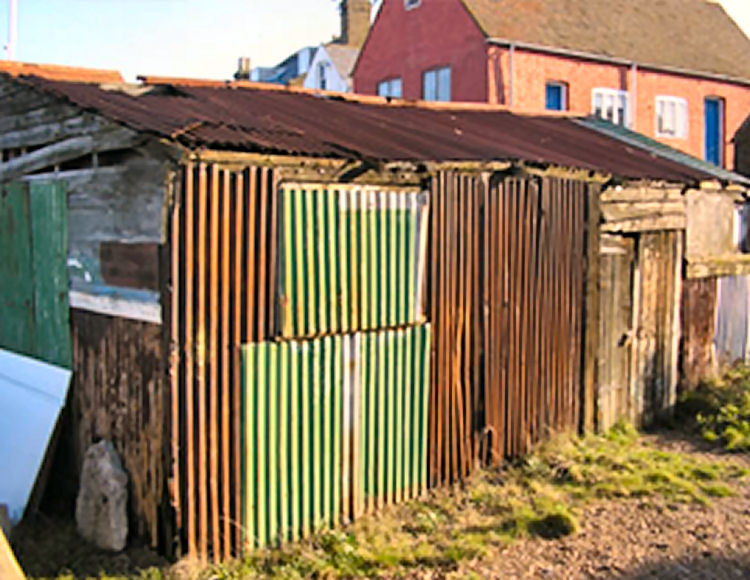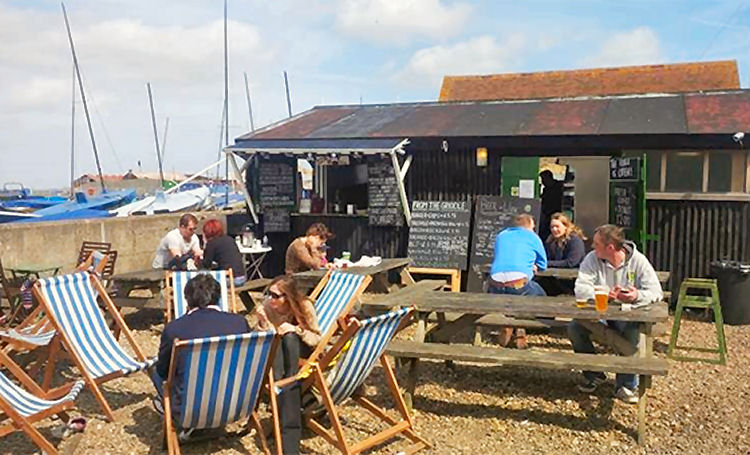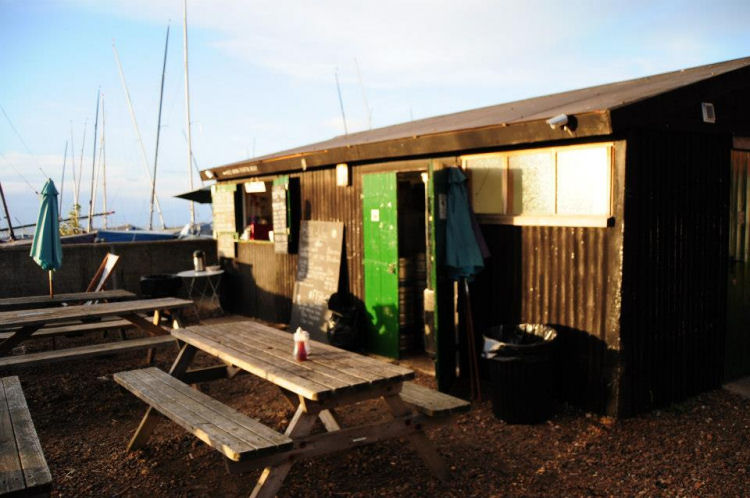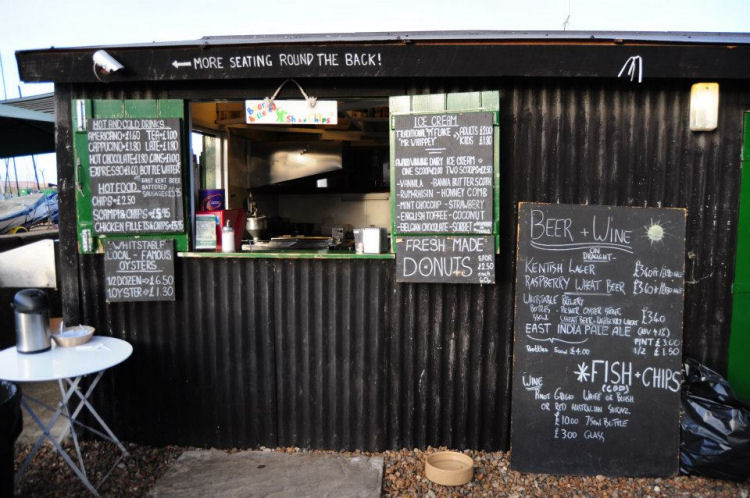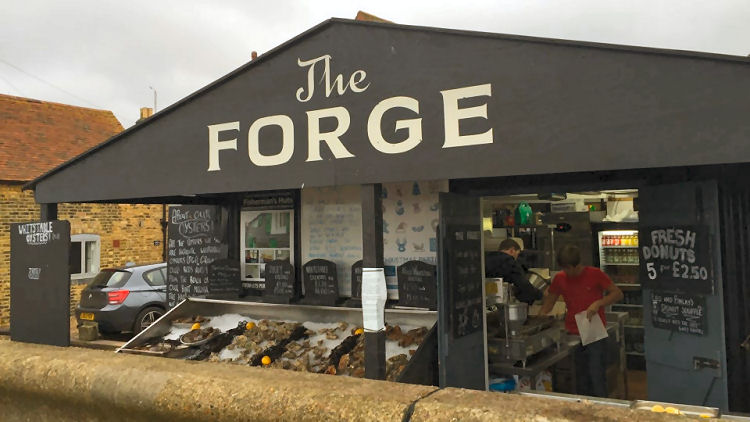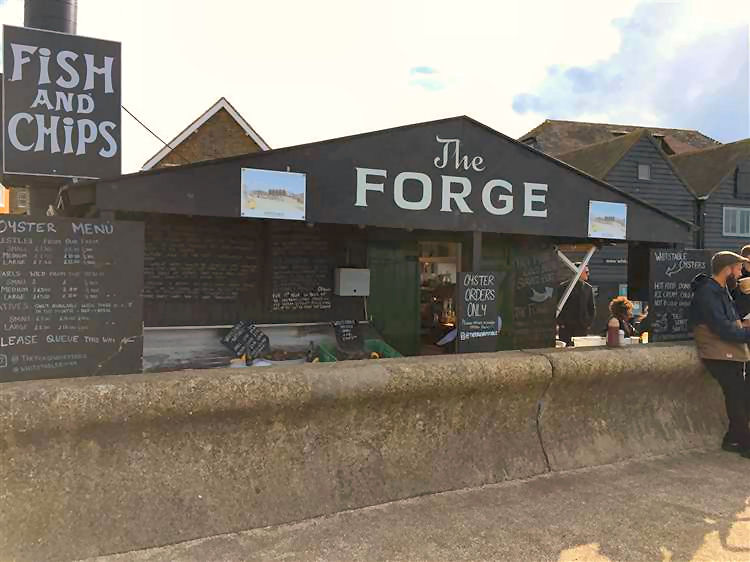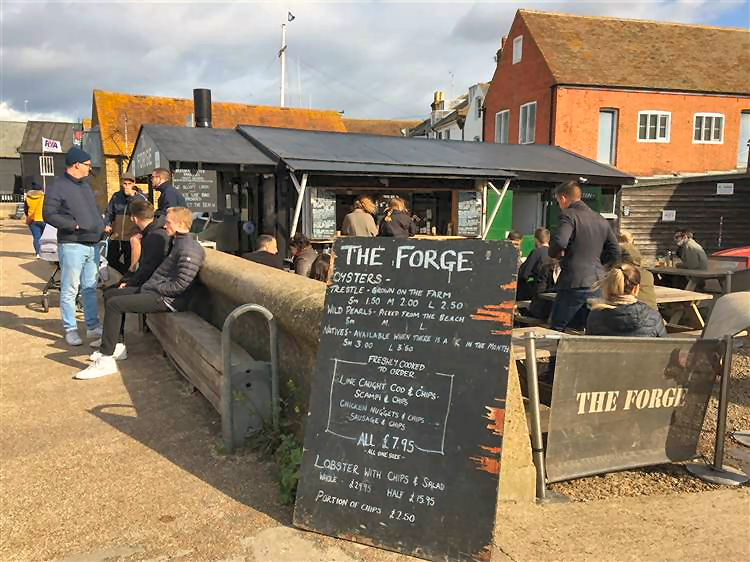|
From
https://www.whitstablefishermanshuts.com/our-history/ accessed 29 September 2019.
The history of our Huts by ‘Rod Joiner’.
I call the buildings Stores as opposed to Huts as this is the way that
all the local people used to refer to them. They seem to be too large to
be called Huts and far to grand to be called Sheds, and as they were
undoubtedly used originally by fisherman to store their gear, Stores
would appear to be the most appropriate name.
In 1869 a disastrous fire destroyed over eighty houses, workshops and
storehouses just to the west of the Harbour. This would have covered the
area where the present Huts now stand. Although it would be difficult to
establish exactly when the buildings in the effected area were replaced
it probably was not too long after the fire. This could well make the
the existing Huts over 130 years old.
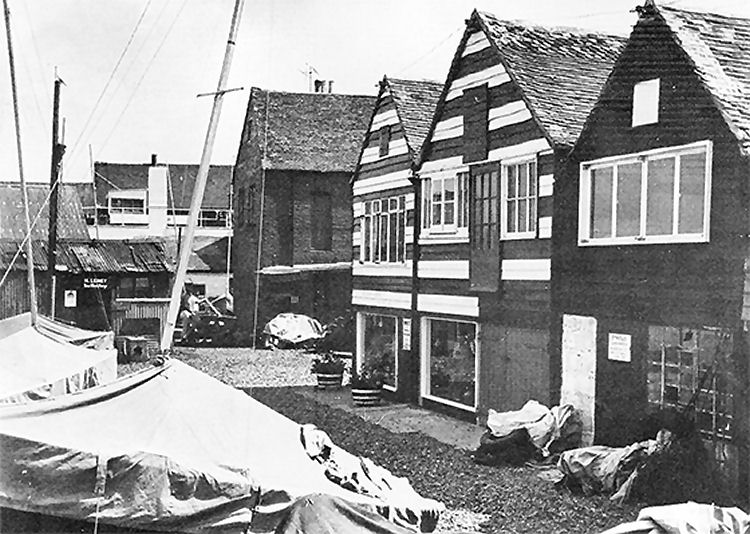
Whitstable Fisherman's Huts.
By the late nineteen forties the Huts were mainly occupied by local
families with a boating interest, either angling or sailing, and only
two remained as professional fisherman’s stores. These were:
No.3 Mr. Stroud owned two ex. oyster smacks and used them for trawling
for shrimps. Nets were hung up to dry on a post erected on the beach in
front of his hut. This business ceased trading in the late fifties and
the Hut continued to be used by his family.
No.10 Occupied firstly by ‘Crutchy Stroud and then by ‘Ogie Laker and
finally by Dave Foreman all of whom were involved in various forms of
fishing.
No.11 Nichols the builders merchants in Harbour Street owned this
building and used it for additional storage. The shop closed in the
nineteen sixties and the Store was sold to Mr Hertford Janes an antique
dealer who stored large items there, he sold the the building to the
W.O.F.Co. when its condition became unusable. It used to sway alarmingly
in high winds and eventually collapsed in the nineteen eighties to be
completely rebuilt in 2010.
In the nineteen fifties Mrs Madge Rigden, wife of Roy Rigden the boat
builder, began to sell yacht fittings etc. from a trestle table outside
No.1. Hut 1 then became the original Dinghy Store, Whitstable’s first
yacht chandlers, eventually expanding to incorporate No.2 as well. In
the mid seventies the Dinghy Store moved to the present much larger
premises along Sea Wall.
Harold Leney was the blacksmith who worked in the Forge. As young lads
we used to stand at his seemingly ever open door and watch as he heated
up pieces of wrought iron and then hammered them into various shapes on
the anvil. As well as making parts for the boatyards and local builders
ice made items such as iron gates. Mr. Leney retired in the nineteen
seventies.
The brick built Store close to the Yacht Club became known as the
Anderson Shed after it was occupied by Mr. Anderson and his family in
the forties. Bob Anderson was an influential man in Whitstable as he was
not only the proprietor of Anderson, Rigden 4 Petkins Itd.
(Whitstable’s largest boatyard) but he was also the Commodore of the
Whitstable Yacht Club and a director of the W.O.F.Co. When he had no
further use for the store it passed to the W, Y.C. and was used for
rescue boat storage. After later negotiations it passed to the W,O.F.Co.
The W.Y.C. gaining the ownership of the Stroud Store, the wooden
building which stands beside it. The majority however were only used for
pleasure, providing storage on the ground floor for rowing dinghies,
various boating equipment and fishing tackle etc. The upper floor would
probably contain a table and some chairs and perhaps a stove for making
tea. As there was no running water or sanitation overnight use was not
permitted, but this did not prevent the users from spending most of the
summer weekends and their holidays’ down at the beach. Such was the
level of activity that in 1953 over thirty Store users gathered in the
nearby Boathouse for a tea party to celebrate the Queens Coronation.
Gradually the community of Store users diminished as the family weekend
use seemed to fall out of fashion., and as a consequence lack of
maintenance caused some of the buildings to fall into a very poor state
of repair. From the nineteen eighties onwards the W.O.F.Co. gradually
took over all of chess wooden buildings and began a programme of
restoration and interior alteration to make them as they are today.
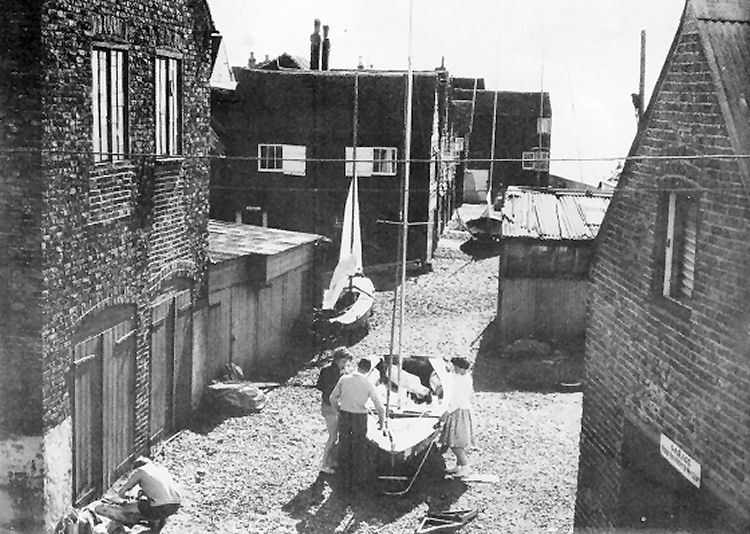
Store occupants in the late forties:
Stroud Shed — Mr. Rains (yachtsman)
Anderson Shed — Bob Anderson (yachtsman)
The Forge — Harold Leney (blacksmith)
No. 1 Eric Wiltshire (yachtsman)
No.2 Mr Peace (yachtsman)
No.3 Mr Stroud (proff. shrimper)
No.4 Herbert Rowden (motor yacht)
No.5 Jim Whorlow (angler)
No.6 Mr Boulting (angler)
No.8 Captain Vapworth (rowing boat hirer)
No.9 Bill Grantham (motor yacht)
No 10 Crutchy Stroud (proff. fisherman)
No 10a Phillip Hays (yachtsman)
No 11 Nichols (builders merchants)
No 12 Les Joiner (yachtsman)
History of the Whitstable Oyster Fishery Co. – The Fisherman’s Huts
owner.
Oysters have been farmed in Whitstable for centuries, but it was not
until 1793 that the industry became highly regulated with the Act of
Incorporation of the ‘Company of Free Fishers and Dredgers of
Whitstable’. It is from this time that the records in this collection
begin. The Company of Free Fishers and Dredgers evolved from the Court
of Fishing and Dredging under the direction of the Lord of the Manor and
his company. This allowed the ‘eldest son of a fisherman at 16 and
others at 21’ to become Freemen, thus bestowing upon them the right to
farm oysters. Most of the profits went to the Freemen but a percentage
was ploughed back into the company to support the widows of past
Freemen.
Lord Bollingbroke, a Lord of the Manor in the 1790s, incurred so many
debts that he was forced to sell the fishing rights, but eventually the
Oysterman established their own company, the Company of Free Fishers and
Dredgers, in 1793. The company was regulated by a group of individuals
elected at the Water Court. The members included the Water Bailiff, the
Foreman and a jury of 12 Freemen. The Freemen were in turn elected from
the annual list of Freemen. (Examples of these lists are to be found in
this collection.) The Company was run as a co-operative with an emphasis
on self-help between its several constituent extended families. In the
early part of the 19th century, the industry flourished. This enabled
the town to increase in population and prosperity.
The Canterbury to Whitstable Railway was opened in 1830 and improved
transportation of the oysters to markets across the country, including
the Canterbury Fish Market and Billingsgate Market in London. Many
papers in the collection detail legal struggles. Towards the end of the
19th century the Company fell on hard times which started with the
importation of cheap oysters from abroad. Then oyster crops failed, due
in part to over-fishing by the increasing number of Freemen, which
resulted in stricter criteria on who could become a Freeman.
The Company also endured many lengthy legal battles over fishing rights
and anchorage and claims due to illness from having eaten contaminated
oysters. Many papers in the collection detail legal struggles. The
Company also suffered at the hands of fraudsters selling inferior
oysters, claiming that they were genuine Whitstable Oysters. The
Company’s problems were further compounded in 1886, when the company
Treasurer disappeared to America with a large proportion of the
Company’s funds. Four years later the sea froze for several weeks and
this was the prelude to several severely cold winters. The now
debt-ridden Company was reconstituted in 1896 under the Companies Act
and the Whitstable Oyster Fishery Company was found. This company was
under the control of a Board of Directors and consisted of shareholders,
this company still trades today selling the world famous Whitstable
oysters that now have PGI status (Protected Geographical Indication).
|
